Iconic South African resort Sun City has taken its name to heart and installed a R16-million solar plant to reduce electricity consumption from the national grid. Located alongside Pilanesberg National Park in North West and experiencing many sunny days, Sun City’s 1.4MW peak-rated, grid-tied solar photovoltaic system ties in at the Sun Central entertainment centre for use around the resort.
The system comprises 2 584 560W monocrystalline solar PV modules on the Sun City Hotel roof, said TM Lesetla, installer and National Energy Engineer at Tsebo Energy Solutions. “These panels will be married to Sun City’s internal electrical network to feed the power produced on the roof to the points of delivery. Sun City is like a little town and the solar capacity is part of the energy mix.”
The plant will displace an equivalent of 2 367 571kWh per year, with the highest levels of energy production expected in nine out of the 12 months.
“This is what 329 average-sized South African households consume over a year. On good sunshine days, which will be most days, the facility will free up an equivalent of 14% of Sun City’s electrical demand from Eskom, which will be to the benefit of the grid in the vicinity, and by extension, local communities that feed off the same supply,” said Sun City General Manager Brett Hoppé.
From a sustainability perspective, the solar plant will see Sun City reduce its annual CO2 equivalent emissions by an estimated 2 510 tons per year – a positive contribution to mitigate against climate change.
“This is one of the many initiatives that Sun International, and Sun City in particular, are rolling out to reduce energy use from both a supply and demand perspective. Efficient lighting, HVAC retrofits and reconfigurations, water-heating, and a gradual move to renewables all form part of the plan,” said Hoppé.
“Sun International’s sustainability approach ensures we continue to realise our vision of providing memorable experiences for our guests, employment for our people, superior shareholder returns, and genuine value for the communities in which we operate and make sure we reduce our environmental footprint.”
The project is expected to pay for itself within five years, driven by above-average annual electricity price escalations. The plant has an expected lifespan of more than 25 years when coupled with a preventative maintenance regime.
Author: Bryan Groenendaal

















